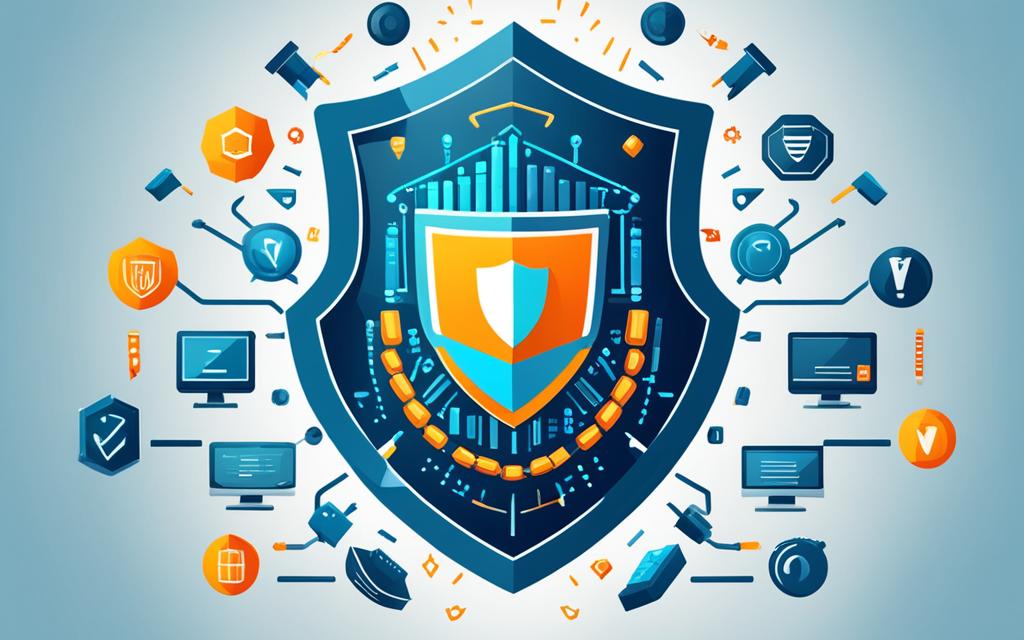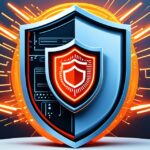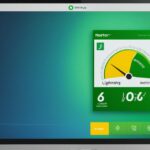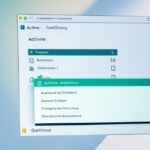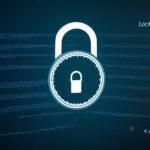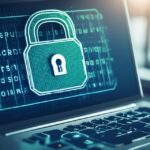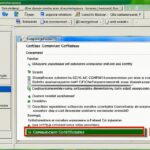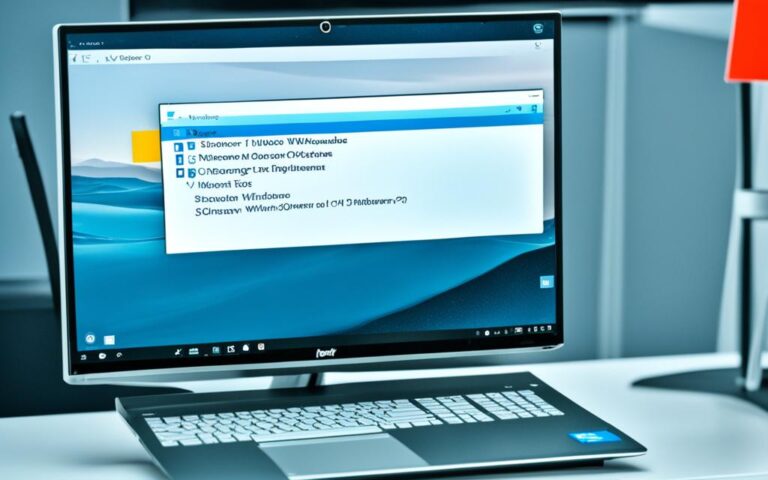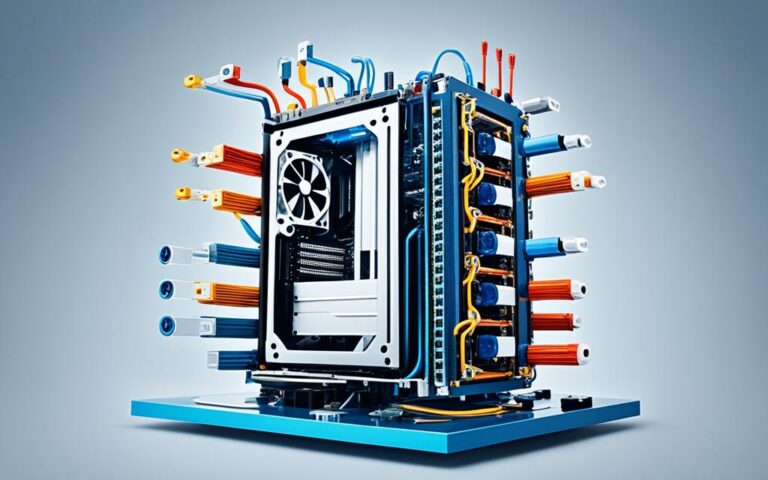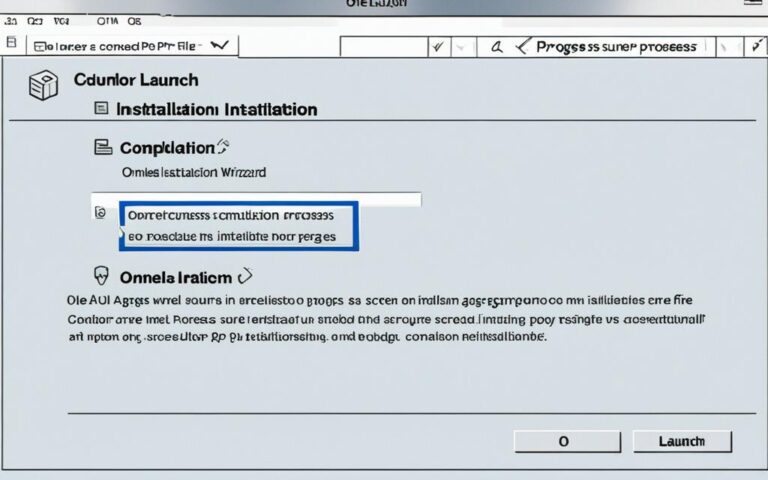Protecting your home computer is vital in today’s digital world. Cyber awareness is key. It’s crucial to act early to keep your info and devices safe from cyber threats.
Default passwords are a big risk for IoT devices, making them easy targets just minutes after connecting to the Internet1. For those working from home, it’s key to check for viruses and keep your antivirus software updated1. The NSA suggests using a strong password for each user account on your computer1. Active military and civilian employees can get antivirus software for personal devices through the DoD Antivirus Home Use Program1.
Windows has a built-in firewall that turns on automatically to protect your computer2. It also comes with Microsoft Security Center or Windows Security for antivirus protection2. If you have Microsoft 365, you get Microsoft Defender for free to protect your devices2. Using Microsoft Edge can block harmful websites and stop malicious code from running2. Avoid downloading pirated stuff as it often has malware that can harm your computer2. Keeping your software, like Windows and Microsoft Office, updated is key to staying safe online2. Be on the lookout for phishing scams that try to steal your info and money online2. Don’t use USBs or devices from people you don’t know to avoid getting malware2. Windows Security or Windows Defender can protect your computer from malware with real-time detection and removal2. Microsoft Defender Offline can also remove rootkits and hidden threats from your Windows system, making your computer safer2.
For home computer security, all DoD Unclassified data needs access and distribution controls3. Classified info that gets out is called spillage, and it’s a big problem3. But, most SCIFs let you store things openly because they’re physically secure3. Remember, most health info isn’t made or kept by healthcare providers or employers3. Also, don’t use DoD PKI tokens for NIPR on SIPR3. Always be careful and only accept cookies from trusted websites when you’re online3.
Key Takeaways:
- Regularly scan files for viruses and keep antivirus software up-to-date1.
- Create strong passwords for user accounts on home computers1.
- Utilize built-in firewall and antivirus protection on Windows operating systems2.
- Avoid downloading pirated material to prevent malware infection2.
- Maintain software updates, including Windows and other applications, for cybersecurity2.
- Be aware of phishing scams and avoid unknown USBs or external devices2.
- Implement access and distribution controls for DoD Unclassified data3.
- Follow security measures for Sensitive Compartmented Information Facilities (SCIFs)3.
- Ensure the proper use of DoD Public Key Infrastructure (PKI) tokens3.
- Accept cookies only from reputable websites when browsing the internet3.
Telework and Home Computer Security
When you start teleworking, keeping your home computer and network safe is key. It’s important to follow your company’s advice and use the right equipment and software. This helps protect sensitive information4.
Here are some tips to make your home computer more secure while working from home:
1. Use a Virtual Private Network (VPN)
A VPN encrypts your internet use and makes a secure link between your computer and your company’s network. This keeps your data safe from being intercepted and keeps your online activities private5. Pick a VPN that fits your security needs54.
2. Secure Your Workspace
Make sure your computer screen is set up so others can’t see your work. If you’re dealing with secret documents, keep them in a safe place and don’t take them out of that area5.
3. Work Online Using Provided Portals or Remote Access
Don’t risk downloading company files on your personal devices. Use the portals or remote access your company offers, like Office 3655.
4. Encryption and Data Protection
Encrypting sensitive data in emails and on devices lowers the chance of it being accessed by others without permission. Use encryption tools and follow your company’s rules for keeping information safe54.
5. Physical Security
Lock your doors and keep your work devices safe from others when you’re working from home. Don’t leave your devices or laptops in cars to avoid theft5.
6. Beware of External Devices
Be careful with random thumb drives as they could have malware or be used for hacking. Don’t plug in devices you don’t know or trust5.
7. Formal Work-from-Home Policies and Security Awareness Training
Having clear work-from-home policies and training your employees on security is key to handling the risks of working remotely5.
| Telework and Home Computer Security Tips | Reference |
|---|---|
| Use a Virtual Private Network (VPN) | 54 |
| Secure Your Workspace | 5 |
| Work Online Using Provided Portals or Remote Access | 5 |
| Encryption and Data Protection | 54 |
| Physical Security | 5 |
| Beware of External Devices | 5 |
| Formal Work-from-Home Policies and Security Awareness Training | 5 |
Peripherals and Wireless Network Security
When using your own computer gear with government equipment, following the rules is key6. Some items like monitors and wired keyboards are okay, but Bluetooth devices aren’t. Sticking to these rules keeps your home setup safe and guards against risks.
For telework, making your home Wi-Fi secure is a must7. Start by turning on Wi-Fi Protected Access 2 (WPA2) for better security. Also, change your router’s default password to stop others from getting in.
Using a Virtual Private Network (VPN) when working from home is also crucial7. A VPN makes your connection to work safer by encrypting it. This keeps your data safe from prying eyes.
Enhancing Peripheral Security
Keeping your computer peripherals safe is just as important as securing your Wi-Fi8. USB drives are handy for moving files around but can be risky. Always use trusted USB drives and scan them for viruses. Keep your antivirus software up to date to stay safe.
Don’t forget about printer security8. When you get a new printer or return an old one, erase all your data. This stops your personal info from being shared.
Be careful with free software, as it might not be as secure as paid options8. Free software can be more likely to have viruses. Always check where you got the software from and make sure it gets updates.
With more identity theft happening, protecting your online info is more important than ever8. Cybercriminals look for people handling personal data online. Use strong passwords, enable multi-factor authentication, and watch your accounts closely to stay safe.
Sources
- For more information on general cybersecurity tips, visit this link.
- To learn about Department of Defense (DOD) cyber hygiene and information security, read this article.
- For comprehensive guidelines on computer use and security provided by the Defense Information Systems Agency (DISA), refer to this document.
Wireless Technology and IoT Devices
Wireless technology is now a big part of our lives. It helps us with wireless peripherals and makes our homes smarter with IoT devices. This tech has changed how we live and work.
A recent study9 found most homes now have devices connected to the internet. These include computers, gaming systems, TVs, tablets, smartphones, and wearables. This connectivity is great but also brings security risks.
Keeping wireless routers secure is key to protecting our networks. A strong password is the best way to stop unauthorized access. It should be at least 12 characters long, mixing letters, numbers, and symbols9.
Choosing the right security for your router is also vital. WPA2 or WPA security is better than WEP9. Using WPA2 or WPA gives strong encryption and keeps out unwanted visitors.
IoT devices, like smart appliances and web cameras, need to be secure too. Manufacturers update these devices to fix security issues and improve safety10. Always check for updates and install them quickly to keep your devices safe.
Setting up a guest network on your router is a good idea, especially for IoT devices. It keeps visitors’ devices separate from yours, lowering the risk of them accessing your private info9.
Firewalls are key to securing our wireless networks and IoT devices. They stop hackers from sending out our personal info without our say-so. Firewalls also block unauthorized access, adding another layer of safety9.
By using these security steps, we can keep our wireless networks and IoT devices safe. With over 75 billion IoT devices expected by 202511, it’s more important than ever to focus on cybersecurity and watch out for new threats.
Best Practices for Home Computer Security
Protecting your home computer is key to keeping your personal info and digital stuff safe. By following best practices, you can lower the chances of cyber threats and identity theft.
1. Password Protection
Make sure your home computer has strong passwords to stop others from getting in. Pick passwords that mix uppercase and lowercase letters, numbers, and symbols. Don’t use easy-to-guess info like your name or birthdate. Change your passwords often and don’t use the same one for different accounts, as 77% of cyber attacks come from using the same password everywhere12.
2. System Updates and Antivirus Software
Keep your computer and antivirus programs updated. Updates often fix security holes and protect against new threats. Use antivirus, anti-phishing, and firewall tools for extra security. 82% of data breaches happen when antivirus protection is not updated13.
3. File Scanning and Backup
Check your files for viruses or malware often. Use automatic scans for ongoing protection. Backing up your data is key to protect against losing it due to hardware failure, theft, or ransomware. Yet, 65% of users don’t back up their data regularly12.
4. Firewall Protection
A firewall keeps your computer safe by controlling internet traffic. Turn on a firewall to block unauthorized access. Most computers come with a firewall you can use.
5. Install Spyware Protection Software
Keep spyware off your computer with protection software. Spyware can steal your info, track your online actions, and slow down your system. Using spyware protection helps keep your privacy safe.
By following these tips, you can make your home computer safer. This helps protect your personal info and lowers the risk of cyber threats and identity theft. Start by being proactive and keeping up with the latest in cybersecurity.
Antivirus Software and File Sharing
Keeping your computer safe from malware and viruses is key in today’s digital world. Using antivirus software is vital to protect your devices and personal info from cyber threats. Recent stats14 show how common malware and data loss are, making it clear we need good software to protect our devices.
Sharing files comes with its own set of risks. First, turn off file sharing when you don’t need it to lower the chance of others accessing your files. Only share files on home or work networks to keep control over who sees them. Adding passwords to shared files also boosts security, making sure only the right people can open them.
Sharing files can be risky if not done carefully. Be careful, especially on public networks, as they might be unsafe. Disabling file sharing on public networks14 reduces risks and keeps your data safe. Also, using passwords on shared files makes it harder for hackers to get into your files.
By sharing files securely, you can share with others without risking your privacy or data. Using these safe sharing methods and antivirus software is key to a secure online life.
| Antivirus Software Usage | Updating Systems and Apps | Firewall Protection | Strong Passwords |
|---|---|---|---|
| Recent stats15 show antivirus software is key to fight viruses that can harm your data, slow down your device, or spread spam. | Updating your systems, browsers, and apps regularly is vital. It helps close security gaps that hackers might use15. | Firewalls are crucial to stop hackers from getting into your computer. They’re especially important for fast internet connections like DSL or cable15. | Strong passwords are a must for security. They should have at least eight characters, mix letters, numbers, and special characters. Using different passwords for each online account helps protect your info15. |
Secure Wi-Fi Network and Multi-factor Authentication
In today’s world, keeping your Wi-Fi safe and using multi-factor authentication (MFA) is key. These steps help protect your online life. They keep your personal info safe and lower the risk of cyber attacks.
First, make sure to change your Wi-Fi router’s default password and username. This simple step stops others from getting into your network. It’s a basic but important security step. [source]
Also, turn on Wi-Fi Protected Access 2 (WPA2) for your network. WPA2 adds an extra layer of security. It makes sure your network talks are safe from prying eyes. [source]
Using multi-factor authentication (MFA) is another great way to boost security. It adds an extra check when you log in to services like email or social media. This could be a code on your phone, a fingerprint scan, or a special token. MFA makes sure only you can get into your accounts, even if someone has your password. [source]
Deloitte’s 2022 Survey found that UK homes have about 22 connected devices on average. It’s vital to keep an eye on these devices for security. Check for unknown devices and block them to stop security breaches. By doing this, you can keep your network safe. [source16].
Securing your Wi-Fi and using MFA are key to keeping your online life safe. By following these tips, you can make a secure online space for you and your family.
| Secure Wi-Fi Network and Multi-factor Authentication | Statistical Data |
|---|---|
| Number of connected devices in the average U.S. household | 22 [source] |
| Recommended frequency of replacing modems/routers for network security | Every five years [source] |
| Importance of enabling automatic updates and installing latest firmware on modems and routers | Protect against emerging vulnerabilities [source] |
| Advisory to change default passwords on modems and routers | Prevent unauthorized access to the network [source] |
| Recommended utilization of Wi-Fi Protected Access 3 (WPA3) encryption | Enhanced security for Wi-Fi networks [source] |
| Suggestion to have a separate Wi-Fi guest network for visitors and web-enabled appliances | Segregate them from trusted devices [source] |
| Importance of reviewing connected devices periodically and blocking unrecognized ones | A proactive approach to network security [source] |
App Security and Social Media Privacy
It’s vital to be careful and proactive when it comes to app security and social media privacy. Always check what an app can do with your data and only get apps from trusted places17. Also, deleting apps you don’t use anymore can reduce risks17.
Social media is a big part of our lives, but we must be careful with what we share. Don’t give out your address or personal details that could be used against you17. Turn off location sharing to keep your exact location private17.
Keeping your social media safe is more than just setting up your account right. Think about what you post as it could be dangerous if mixed with other info. Manage who can see your posts and info17.
Remember, social media sites change their privacy rules often. Always check and update your privacy settings17. By being proactive, you can decide what to share and keep your data safe on social media.
Best Practices for App Security and Social Media Privacy
Follow these tips to boost your app security and social media privacy:
- Check what an app can do with your data and get it from trusted places.
- Remove apps you don’t use anymore.
- Keep your address and personal details private on social media.
- Turn off location sharing.
- Control who sees your posts and info on social media.
- Keep an eye on and update your privacy settings regularly.
Importance of Protecting Personal Information Online
Keeping your personal info safe online is crucial. Windows Security in Windows helps protect you from malware by detecting, preventing, and removing it2. Use a modern browser like Microsoft Edge and steer clear of risky websites to stay safe online2. It’s also key to spot and report phishing scams to keep your online world secure172. Scammers often aim for your personal and financial info, so be careful with emails, social media, and online activities172.
Internet Provider and Router Security
Securing your home network is key, and that includes your internet provider and router security. By taking steps, you can keep your data safe and enjoy a secure online experience.
Securing Your Internet Provider
Your internet provider is a big part of your online safety. Choose a trusted provider that values customer safety and has strong security features. Look on their website for details on their security measures.
One important fact18 shows the value of owning your router. Having control over your router means you can set up security that fits your needs. This helps protect your network from threats.
It’s also wise to turn off IPv6 tunneling. This stops hidden channels that attackers could use. By doing this, you make your network safer and reduce the risk of unauthorized access.
Ensuring Router Security
Your router is the gateway to your network, so it’s vital to keep it secure. Here are some steps to make your router more secure:
- Change the default username and password. Hackers easily find these online, which could lead to network breaches19.
- Use Wireless Network Encryption, especially WPA2, to scramble your data. This makes it hard for hackers to access19.
- Use a VPN when on public Wi-Fi. This encrypts your data and keeps your online activities private19.
- Hide your network’s SSID and turn off Wi-Fi when not in use. This lowers the risk of attacks19.
- Update your router’s software regularly. Old firmware can have vulnerabilities hackers might use, so keep it updated19.
- Enable your router’s built-in firewalls for extra protection against attacks. These firewalls help safeguard your internet connection19.
- Put your router in the middle of your home to stop Wi-Fi signals from being intercepted by others19.
- Use MAC Address Filtering to only allow devices with certain MAC addresses to connect. This boosts security19.
- Turn off Remote Administration if you don’t need it. This stops unauthorized access to your Wi-Fi settings, making your network safer19.
Following these tips can greatly improve your internet provider and router security. This creates a strong defense against cyber threats.
| Internet Provider and Router Security Statistics | Reference |
|---|---|
| 64-bit OS on a 64-bit hardware platform substantially increases the effort for an adversary to obtain privileged access on your computer18. | 18 |
| Personally-owned routing devices provide maximum control over home network routing and wireless features18. | 18 |
| Disabling Internet Protocol Version 6 (IPv6) tunneling mechanisms can prevent hidden communication channels for attackers18. | 18 |
| Changing the default username and password is crucial to secure a home Wi-Fi network since hackers can easily find default passwords online, potentially leading to network hijacking19. | 19 |
| Utilizing Wireless Network Encryption, with WPA2 encryption as the most secure option, enhances network data protection by scrambling data so hackers cannot decipher it19. | 19 |
| VPN (Virtual Private Network) usage encrypts data over unsecured networks and alters the IP address, providing increased privacy when browsing online19. | 19 |
| Hiding the network’s SSID (Service Set Identifier) and turning off the Wi-Fi network when not at home can help mitigate security risks, reducing the chance of attacks19. | 19 |
| Keeping router software up to date is essential to protect the home network, as outdated firmware can contain vulnerabilities exploited by hackers19. | 19 |
| Enabling built-in firewalls on Wi-Fi routers adds an extra layer of protection against network attacks, protecting the broadband connection19. | 19 |
| Placing the router in the center of the home rather than near doors or windows can prevent the interception of Wi-Fi signals by malicious individuals19. | 19 |
| MAC Address Filtering restricts network access to approved devices by only allowing connections from specified MAC addresses, enhancing security19. | 19 |
| Disabling Remote Administration on routers prevents unauthorized access to Wi-Fi settings and is advisable if remote connection is unnecessary19. | 19 |
Identity Authentication and Password Security
In today’s digital world, keeping your identity and passwords safe is key. It helps protect your personal info and online accounts. By using best practices, you can lower the risk of unauthorized access and data breaches.
“DoD is moving toward using two-factor authentication wherever possible.”7
Using two-factor authentication (2FA) is a great way to boost your security. It makes your account safer by asking for a second code or step besides your password. This means even if someone gets your password, they still can’t get in without the second code.
It’s also smart to change your passwords often. Experts say to change them every 3 months to stay safe. This helps stop unauthorized access.
“Avoid using the same password between systems or applications.”7
Don’t use the same password for all your accounts. If one account gets hacked, the hacker won’t get into your others too.
For top-secret systems, like the Department of Defense, special security tokens are used. These tokens add an extra layer of security. They make sure only the right people can see sensitive info.
“Wireless technology can be compromised within two minutes of connecting to the Internet.”7
“IoT devices can be compromised within two minutes of connecting to the Internet.”7
Wireless tech and IoT devices can be risky. It’s important to keep them safe. Use strong passwords, update their software, and use encryption to protect them.
Cookies can be a security risk if they store your personal info without encrypting it. Be careful about which websites you let save cookies on your device.
By following these tips, you can keep your online identity and info safe. This includes your personal information, online accounts, and digital identity.
| Recommendation | Details |
|---|---|
| Utilize Two-Factor Authentication (2FA) | Implement 2FA wherever possible to provide an additional layer of security. |
| Change Passwords Regularly | Follow best practice by changing passwords at least every 3 months. |
| Avoid Password Reuse | Use unique passwords for different systems and applications to prevent unauthorized access. |
| Implement Smart Card Security Tokens | For sensitive systems, utilize smart card security tokens for enhanced authentication. |
| Secure Wireless Technology and IoT Devices | Take proactive measures to protect wireless networks and IoT devices from potential vulnerabilities. |
| Be Cautious with Cookies | Take care when accepting cookies, particularly from less reputable websites. |
Statistical Data References:
- DoD is moving toward using two-factor authentication wherever possible7.
- Wireless technology can be compromised within two minutes of connecting to the Internet7.
- IoT devices can be compromised within two minutes of connecting to the Internet7.
Conclusion
Keeping your home computer safe and being aware of cyber threats is key to protecting your personal info. Many statistics show we need to act now to stay secure online. This is vital in our digital world.
Ransomware attacks have jumped by 62%20, and phishing scams by 40%20. This shows cybercriminals are getting smarter. Both small businesses and individuals are at risk. So, it’s vital to know more about staying safe online21.
Using strong passwords and two-factor authentication can boost your security21. Also, keep your IoT devices updated and stay updated on cyber threats. This helps in fighting off attacks21. Making sure your software and systems are up-to-date can stop up to 80% of cyber attacks22.
By following these steps, both businesses and individuals can shield themselves from cyber threats. Cyber attacks on small and medium businesses cost about $200,000 a year22. Regular backups and strict access controls can greatly lower the chance of a successful attack22.
FAQ
Why is it important to protect your home computer?
Keeping your home computer safe is key in today’s digital world. It helps protect your personal info and devices from cyber threats.
What steps should I take to protect my home computer while teleworking?
When working from home, follow your company’s advice. Use only approved gear and software. Also, use a VPN and keep your screen private.
Can I use my personally-owned computer peripherals with government-furnished equipment?
Yes, you can use some personal items like monitors and wired keyboards. But, Bluetooth devices are not allowed. Always check your work’s rules first.
How can I secure my home wireless network for telework?
Make your home Wi-Fi safe by using WPA2 encryption. Change your router’s default password. Also, connect to a VPN when online.
What security risks are associated with wireless technology and IoT devices?
Wireless tech and IoT devices can be risky if not set up right. Things like smart thermostats and cameras can be hacked. Make sure to check their security settings, use strong passwords, and update them often.
What are some best practices for home computer security?
Keep your computer safe by turning on password features. Install security updates and antivirus software. Regularly scan for viruses and use a firewall. Back up your files and think about getting spyware protection.
How can I protect my computer from malware and viruses?
Use antivirus software, which some agencies offer for free or at a discount. Don’t share files unless needed. Only share files over safe networks and protect them with passwords.
How can I secure my Wi-Fi network and enhance authentication?
Secure your Wi-Fi by changing its password and using WPA2 encryption. Improve security by adding a second step to log in, like a code sent to your phone.
What precautions should I take regarding app security and social media privacy?
Be careful with apps and check what they can do. Delete unused apps and get them from trusted places. Share less on social media and turn off location sharing.
Where can I find information on securing my wireless network from my internet provider and router manufacturer?
Look at your internet service and router maker’s websites for tips on securing your Wi-Fi. They might have guides or advice on keeping your network safe.
How can I ensure identity authentication and password security?
Use two-factor authentication to prove who you are and add an extra layer of security. Make strong passwords with a mix of letters, numbers, and symbols. Don’t use easy-to-guess info. Follow your work’s rules on passwords.
Source Links
- https://dl.dod.cyber.mil/wp-content/uploads/trn/online/disa-cac-2024/pdf/DISA_CAC2024_TeleworkHomeComputerSecurity.pdf – Cyber Awareness Challenge 2024 Telework and Home Computer Security
- https://support.microsoft.com/en-us/windows/keep-your-computer-secure-at-home-c348f24f-a4f0-de5d-9e4a-e0fc156ab221 – Keep your computer secure at home
- https://airforcehub.com/cyber-awareness-challenge-2024/ – Cyber Awareness Challenge 2024
- https://www.cybereason.com/blog/cyber-security-tips-for-allowing-employees-to-work-from-home – Cyber Security Tips for Allowing Employees to Work From Home
- https://www.criticalinsight.com/blog/8-best-practices-for-working-remotely – 8 Best Cybersecurity Practices for Working Remotely
- https://www.aetc.af.mil/News/Article-Display/Article/3431998/dod-cyber-hygiene-information-security-helps-protect-from-cybersecurity-threats/ – DOD | CYBER HYGIENE | Information security helps protect from cybersecurity threats
- https://dl.dod.cyber.mil/wp-content/uploads/trn/online/disa_cac_2022_final_web/pdf/DISA_CAC2022_ComputerUse.pdf – Cyber Awareness Challenge 2022 Computer Use
- https://www.edutech.nd.gov/cybersecurity-awareness/security-tips/general-tips – NDIT-EduTech General Security Tips
- https://staysafeonline.org/online-safety-privacy-basics/securing-your-home-network/ – Securing Your Home Network
- https://www.linkedin.com/pulse/safeguarding-internet-things-essential-tips – Safeguarding the Internet of Things: essential tips for cyber security
- https://digitalskills.sdsu.edu/cybersecurity/what-does-the-rise-of-iot-devices-mean-for-cybersecurity/ – What Does the Rise of IoT Devices Mean for Cybersecurity?
- https://security.berkeley.edu/resources/best-practices-how-to-articles/top-10-secure-computing-tips – Top 10 Secure Computing Tips
- https://media.defense.gov/2023/Feb/22/2003165170/-1/-1/0/CSI_BEST_PRACTICS_FOR_SECURING_YOUR_HOME_NETWORK.PDF – PDF
- https://www.cisa.gov/sites/default/files/publications/Cybersecurity%20Awareness%20Month%202021%20-%20Protecting%20Your%20Digital%20Home%20Tip%20Sheet_0.pdf – Cybersecurity Awareness Month – Protecting Your Home Tip Sheet
- https://oag.ca.gov/privacy/facts/online-privacy/protect-your-computer – Protect Your Computer From Viruses, Hackers, and Spies
- https://www.cyber.gc.ca/en/guidance/cyber-security-home-and-office-secure-your-devices-computers-and-networks-itsap00007 – Cyber security at home and in the office: Secure your devices, computers, and networks (ITSAP.00.007) – Canadian Centre for Cyber Security
- https://www.nist.gov/blogs/taking-measure/stay-safe-and-secure-online-during-cybersecurity-awareness-month-and-all-year – Stay Safe and Secure Online During Cybersecurity Awareness Month — and All Year
- https://dodcio.defense.gov/Portals/0/Documents/Cyber/Slicksheet_BestPracticesForKeepingYourHomeNetworkSecure_Web_update.pdf – Best Practices for Keeping Your Home Network Secure
- https://www.metacompliance.com/blog/cyber-security-awareness/top-10-tips-to-protect-your-home-wi-fi-network – 10 Essential Tips To Secure Your Home Wi-Fi Network
- https://gimkit.uk/cyber-awareness-2024-guide-to-protecting-home-computer/ – How Can You Protect Your Home Computer Cyber Awareness 2024 Guide Gimkit
- https://medium.com/@randykovak04/shielding-your-digital-fortress-a-guide-to-home-computer-cyber-awareness-4edd48577de5 – “Shielding Your Digital Fortress: A Guide to Home Computer Cyber Awareness”
- https://leaf-it.com/10-ways-prevent-cyber-attacks/ – 10 Ways to Prevent Cyber Attacks – Leaf
